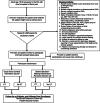Feasibility and efficacy of a decision aid for emergency department patients with suspected ureterolithiasis: protocol for an adaptive randomized controlled trial
- PMID: 33691760
- PMCID: PMC7944622
- DOI: 10.1186/s13063-021-05140-9
Feasibility and efficacy of a decision aid for emergency department patients with suspected ureterolithiasis: protocol for an adaptive randomized controlled trial
Abstract
Background: Approximately 2 million patients present to emergency departments in the USA annually with signs and symptoms of ureterolithiasis (or renal colic, the pain from an obstructing kidney stone). Both ultrasound and CT scan can be used for diagnosis, but the vast majority of patients receive a CT scan. Diagnostic pathways utilizing ultrasound have been shown to decrease radiation exposure to patients but are potentially less accurate. Because of these and other trade-offs, this decision has been proposed as appropriate for Shared Decision-Making (SDM), where clinicians and patients discuss clinical options and their consequences and arrive at a decision together. We developed a decision aid to facilitate SDM in this scenario. The objective of this study is to determine the effects of this decision aid, as compared to usual care, on patient knowledge, radiation exposure, engagement, safety, and healthcare utilization.
Methods: This is the protocol for an adaptive randomized controlled trial to determine the effects of the intervention-a decision aid ("Kidney Stone Choice")-on patient-centered outcomes, compared with usual care. Patients age 18-55 presenting to the emergency department with signs and symptoms consistent with acute uncomplicated ureterolithiasis will be consecutively enrolled and randomized. Participants will be blinded to group allocation. We will collect outcomes related to patient knowledge, radiation exposure, trust in physician, safety, and downstream healthcare utilization.
Discussion: We hypothesize that this study will demonstrate that "Kidney Stone Choice," the decision aid created for this scenario, improves patient knowledge and decreases exposure to ionizing radiation. The adaptive design of this study will allow us to identify issues with fidelity and feasibility and subsequently evaluate the intervention for efficacy.
Trial registration: ClinicalTrials.gov NCT04234035 . Registered on 21 January 2020 - Retrospectively Registered.
Keywords: Computed tomography; Kidney stones; Medical imaging; Randomized controlled trial; Shared Decision-Making; Ultrasound.
Conflict of interest statement
The authors declare that they have no competing interests.
Figures
References
-
- Schoenfeld EM, Pekow PS, Shieh M-S, Scales CD, Lagu T, Lindenauer PK. The diagnosis and management of patients with renal colic across a sample of US hospitals: high ct utilization despite low rates of admission and inpatient urologic intervention. PLoS One. 2017;12(1):e0169160. doi: 10.1371/journal.pone.0169160. - DOI - PMC - PubMed
-
- Schoenfeld EM, Shieh M-S, Pekow PS, Scales CD, Munger JM, Lindenauer PK. Association of patient and visit characteristics with rate and timing of urologic procedures for patients discharged from the emergency department with renal colic. JAMA Netw Open. 2019;2(12):e1916454. doi: 10.1001/jamanetworkopen.2019.16454. - DOI - PMC - PubMed
Publication types
MeSH terms
Associated data
Grants and funding
LinkOut - more resources
Full Text Sources
Other Literature Sources
Medical




